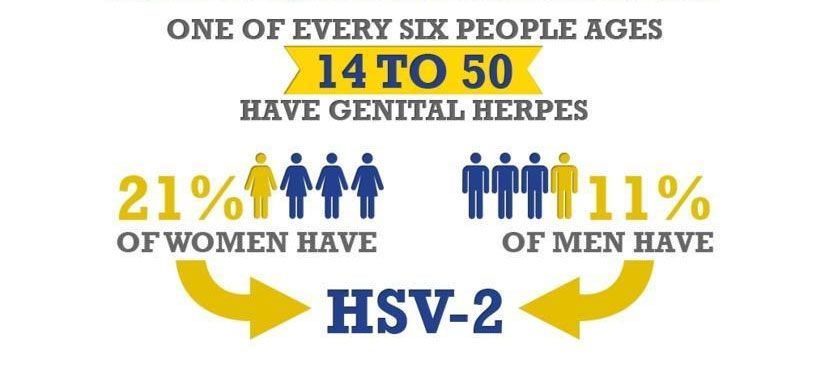How easily transmissible is HSV-2?
According to the CDC, about 1 in 8 people aged 14 to 49 in the U.S. have HSV-2 infection.

Herpes simplex virus type 2 (HSV-2) is primarily transmitted through direct skin-to-skin contact with an infected person, particularly during sexual activity. Several factors contribute to the ease of transmission of HSV-2.
Genital herpes is transmitted from one person to another through sexual contact. Sexual contact includes intercourse, oralgenital contact and rubbing the genitals together without clothing in between (sometimes known as “outercourse”).
When someone has a cold sore on their mouth or simply an oral infection with no sores present, and is the giver of oral sex to someone else, the virus can be spread from the mouth to the genitals. The receiver of the oral sex might then get genital herpes type 1.
The virus type doesn't change (that is, it doesn't change from type I to type II because it is in the genital area), but the cold sore virus will simply live, and possibly recur, in the area of the genitals. Cold sores have been around for a long, long time, and some people find it hard to accept that these can indeed be the source of genital herpes infections.
But as oral sex becomes more common, the incidence of getting genital herpes in this way is increasing. Anal intercourse can also transmit the virus to the rectal area, , though remember, many people who get herpes outbreaks around the rectum and the buttocks have not had anal sex.
Mucosal Transmission
HSV-2 is highly efficient at infecting mucosal surfaces, such as those found in the genital and anal areas. Mucosal tissues provide a direct entry point for the virus, making transmission more likely during sexual contact.
Asymptomatic Shedding
Even when individuals with HSV-2 do not have visible symptoms (asymptomatic), the virus can still be shed from the genital or anal areas.
Asymptomatic shedding can occur at any time, increasing the risk of transmission, as people may not be aware that they are contagious.
2024 No.1 Herpes Dating Site

Don't let herpes keeping you from dating. Meet nearby HSV-2 positive singles now!
Prevalence is higher among women than men. Women are more likely to have genital herpes. This might be because it is easier for the virus to transmit from a man to a woman via penile-vaginal sex.
How likely is HSV-2 transmission?
Peoople with herpes can spread genital herpes by having vaginal, anal, or oral sex with someone. Herpes is most contagious when sores are open and wet, because fluid from herpes blisters easily spreads the virus.
Herpes is easily spread from skin-to-skin contact with someone who has the virus.They can get it when their genitals and/or mouth touch the genitals and/or mouth — usually during oral, anal, and vaginal sex.
Herpes can be passed even if the penis or tongue doesn’t go all the way in the vagina, anus, or mouth. People don’t have to cum to spread herpes. All it takes is some quick skin-to-skin touching. People can also get herpes from kissing someone who has herpes.
The skin on their genitals, mouth, and eyes can be infected easily. Other areas of skin may get infected if there’s a way for the herpes virus to get in, like through a cut, burn, rash, or other sores.
Herpes can also “shed” and get passed to others when there are no sores and the skin looks totally normal. Most people get herpes from someone who doesn’t have any sores. In 70 percent of cases, infection transmitted at a time when there were no symptoms.
Herpes may live in your body for years without causing any symptoms, so it’s really hard to know for sure when and how you got it. That’s why so many people have herpes — it’s a pretty sneaky infection.
One study examined rates of HSV-2 transmission in heterosexual couples when only one partner was initially infected. Over one year, the virus was transmitted to the other partner in 10 percent of couples.
2024 No.1 Herpes Dating Site

Don't let herpes keeping you from dating. Meet nearby HSV-2 positive singles now!
However, the ease of transmission can vary depending on several factors:
Presence of Symptoms: The risk of transmission is generally higher when the infected person is experiencing active symptoms, such as genital sores or lesions. However, it's important to note that HSV-2 can also be transmitted when the infected person is asymptomatic (not showing any symptoms).
Viral Shedding: Even when an infected person is not experiencing visible symptoms, they can still shed the virus and be contagious. The frequency of viral shedding varies among individuals. Some people may shed the virus more frequently than others.
Mucosal Contact: Transmission is most efficient when there is direct contact with the mucosal surfaces of the genital or anal area. Using barrier methods such as condoms during sexual activity can significantly reduce the risk of transmission.
Genital vs. Oral Transmission: HSV-2 is primarily associated with genital herpes, and its transmission is more commonly linked to genital or anal contact. While it is possible for HSV-2 to be present in the oral area, the risk of transmission through oral contact is generally lower compared to genital contact.
Individual Immune Response: The immune response of the infected and uninfected individuals can also influence the likelihood of transmission. Some individuals may have a more effective immune response, reducing the risk of transmission.
It's important to recognize that no sexual activity is completely risk-free, and there is always some level of risk when engaging in intimate contact with an infected partner. Practicing safer sex, using barrier methods, and communicating openly with partners about sexual health can help reduce the risk of HSV-2 transmission. Additionally, individuals with concerns about herpes or other sexually transmitted infections should consult with a healthcare professional for guidance and testing.